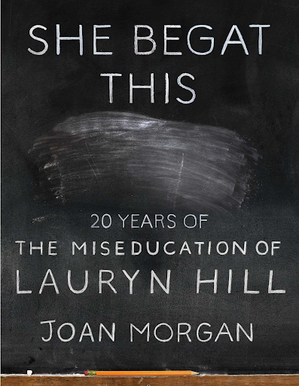SHE BEGAT THIS
20 Years of The Miseducation of Lauryn Hill
20 Years of The Miseducation of Lauryn Hill
By Joan Morgan
Joan Morgan, the creator of “Hip-Hop Feminism”, has returned with her first book in nearly two decades an intricate dissection of the enigmatic history, purpose and impact of Ms. Lauryn Hill. In her book, She Begat This: 20 Years Of The Miseducation of Lauryn Hill, Joan Morgan analyzes an album that has been both celebrated and debated on by nearly all Hip Hop platforms within this past year as the generation it was initially released to reminisces over what the album meant to them, while the new generation reframes the meaning and the significance of the album and applies it to what society looks like today. Published by Simon & Schuster, She Begat This is a book for Hip Hop heads and black history / music historians as it provides a clear insight of how the album has remained on a pedestal during the new millenium.
|
Joan Morgan explores how a single album garnered enough influence to successfully influence conversations of race, love, femininity, sexuality, motherhood, beauty, blackness, and authenticity. Through her own teachings, experience, and interviews Morgan makes a case as to why Lauryn Hill was and remains an important figure in hip-hop, fashion, and discussions of black womanhood and argues that the gravity of Miseducation goes beyond the audible. In her discourse of colorism, fashion, and presence, Morgan argues that the visual components of Lauryn Hill made just as much of a statement as the lyrics in her songs by exposing the dynamics of blackness and by making those complexities acceptable. She notes the ways in which Lauryn was influenced by African, West Indian (particularly Haitian and Jamaican), and Black diasporas but then went on to influence those very same cultures with an effortless sense of intersectionality.
Morgan doesn’t limit her exploration to the lens of hip-hop. She takes note of the ways in which the album, and Lauryn Hill during the time of which the album was released, was both a political and social statement which magnifies the significance of the album. She provides statistical and historical facts to support her arguments surrounding colorism, race, and the magnitude of what it meant to the black community to have Lauryn Hill achieve the success that she has. This is not to say that Morgan ignores the controversy surrounding the making of the album, or controversy Lauryn Hill has since encountered. However, she makes a point of not allowing the gossip and naysayers to take center stage in the conversation. Instead, she provides perspective of why these occurrences may have happened and offers a critique to the audiences who so willingly consume negative stories and opinions surrounding a black woman who did so much for black culture. Morgan explores Miseducation through a Feminist, American, and Multicultural lens providing a well thought out analysis of The Miseducation Of Lauryn Hill. It would be unsurprising if this book ended up on the required reading list for Media studies, Black Women in History, and Music courses as Morgan dives deep into each of those areas with her analysis. While I wouldn’t be surprised if a few millennial journalist and academics provide a counter argument to her discussions on the younger generations relationship and views regarding the album, Morgan’s first chapter and forward, written by Kierna Mayo, are very judgy of who they think are judgy millennials, this book is a great first step for anyone who wants to partake in any discussion revolving around Lauryn Hill, Hip-Hop, Black Women, and our Miseducation. Joan Morgan is an accomplished writer, journalist, and professor. |



